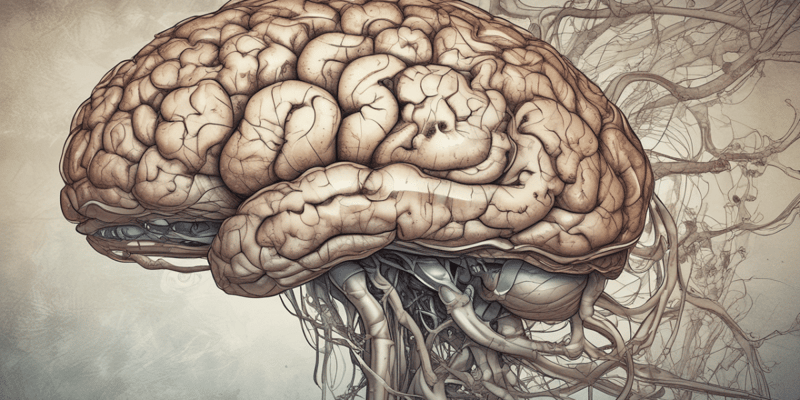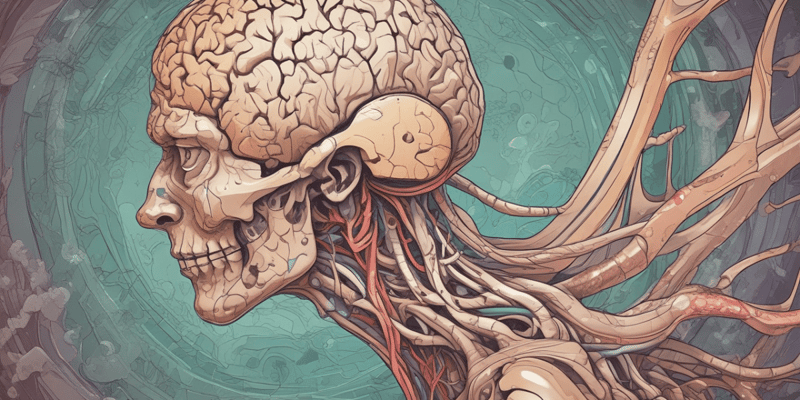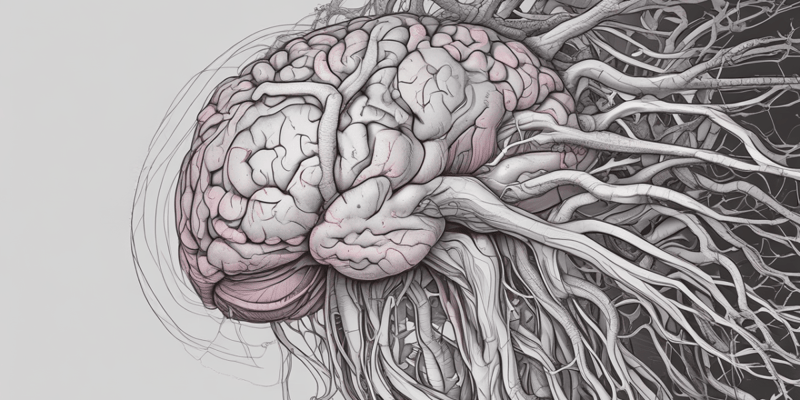Questions and Answers
Which cortical lobe is primarily associated with emotional control and personality?
Which brain structure acts as a bridge between the cerebral hemisphere and the cerebellum?
What is the primary function of the cerebellum?
Which of the following non-dominant parietal lobe functions involves spatial orientation?
Signup and view all the answers
Which cranial nerve functions are predominantly housed in the brainstem?
Signup and view all the answers
What splits the cerebellum from the occipital lobe?
Signup and view all the answers
Which function would NOT typically be associated with the dominant temporal lobe?
Signup and view all the answers
Which part of the brain contains the three major lobes: flocculonodular, anterior, and posterior?
Signup and view all the answers
What is the primary function of the extrapyramidal system?
Signup and view all the answers
Which parts of the spinal cord are known as the conus medullaris?
Signup and view all the answers
What shape does the gray matter resemble in a transverse section of the spinal cord?
Signup and view all the answers
What are the two main divisions of the peripheral nervous system?
Signup and view all the answers
Which fibers in the spinal cord are responsible for the primary processing of sensory information?
Signup and view all the answers
Where do cranial nerves emerge from?
Signup and view all the answers
What is the major role of white matter in the spinal cord?
Signup and view all the answers
Which of the following statements is FALSE regarding spinal nerves?
Signup and view all the answers
Which cranial nerve is primarily responsible for the sense of smell?
Signup and view all the answers
Which cranial nerve controls the lateral rectus muscle responsible for eye movement?
Signup and view all the answers
What functions does the trigeminal nerve serve?
Signup and view all the answers
Which cranial nerve is associated with taste sensation from the anterior two-thirds of the tongue?
Signup and view all the answers
What is the primary function of the hypoglossal nerve?
Signup and view all the answers
Which cranial nerve provides sensation to the pharynx and secretory fibers to the parotid gland?
Signup and view all the answers
What is the main objective in the approach to a patient with neurologic disease?
Signup and view all the answers
Which cranial nerve has a sensory role specifically focused on balance?
Signup and view all the answers
What is the first step in achieving a neurological diagnosis according to the outlined process?
Signup and view all the answers
Which question is aimed at determining the location of the nervous system lesion?
Signup and view all the answers
Which aspect of neurological diagnosis involves evaluating the temporal profile of symptoms?
Signup and view all the answers
What is emphasized as a critical component of the neurological diagnosis process?
Signup and view all the answers
What does the term 'temporal profile' refer to in neurological assessment?
Signup and view all the answers
Which method is explicitly mentioned for answering the question 'what' in neurological diagnosis?
Signup and view all the answers
What should be done after gathering information during neurological assessment?
Signup and view all the answers
Which term describes the onset of symptoms reaching completion immediately?
Signup and view all the answers
Which condition is categorized as a neurological emergency that requires immediate intervention?
Signup and view all the answers
When taking a neurological history, which detail is least relevant to understanding the patient's presenting complaint?
Signup and view all the answers
In a neurological history, which aspect is important when assessing the pattern of symptoms?
Signup and view all the answers
Which of the following symptoms would most suggest a possible case of Guillain–Barré syndrome?
Signup and view all the answers
Which factor would least likely affect the neurological history taking related to the patient's functionality?
Signup and view all the answers
What is an important associated symptom to inquire about when assessing neurological conditions?
Signup and view all the answers
Study Notes
Anatomy of the Cerebral Cortex
- Brain divided into four primary lobes: Frontal, Parietal, Temporal, and Occipital.
- Frontal Lobe: Responsible for personality, emotional control, social behavior, language, motor control, and micturition.
- Parietal Lobe (Dominant): Handles language and calculation. (Non-Dominant): Focuses on spatial orientation and constructional skills.
- Temporal Lobe (Dominant): Involved in verbal memory and smell. (Non-Dominant): Manages auditory perception (melody/pitch) and non-verbal memory.
- Occipital Lobe: Primarily responsible for visual processing.
Brainstem
- Consists of the midbrain, pons, and medulla.
- Connects cerebral hemispheres via cerebral peduncles and cerebellum via cerebellar peduncles.
- Contains all sensory and motor pathways entering and leaving hemispheres, as well as cranial nerve nuclei and reticular formation neurons.
The Cerebellum
- Located in the posterior fossa, adjacent to the occipital lobe, separated by the tentorium cerebelli.
- Involved in balance and the refinement of voluntary movements.
- Divided into three lobes: flocculonodular, anterior, and posterior.
- Integrates with the basal ganglia for muscle tone and body posture control via the extrapyramidal system.
The Spinal Cord
- Lies in the spinal canal and ends at the lower border of the L1 vertebra.
- Contains conus medullaris (S3-S5 segments) and epiconus (L4-S2 segments).
- Composed of gray matter (H-shaped on transverse section) surrounded by white matter, which contains ascending and descending nerve fibers.
- Serves as the major communication route between peripheral structures and the central nervous system (CNS).
Peripheral Nervous System (PNS)
- Encompasses nerves and ganglia outside the brain and spinal cord.
- Comprised of two divisions: somatic nervous system and autonomic nervous system.
- Contains cranial and spinal nerves; 12 pairs of cranial nerves and 31 pairs of spinal nerves.
Cranial Nerves
- I - Olfactory: Sensory for smell.
- II - Optic: Sensory for vision.
- III - Oculomotor: Motor for extra-ocular muscles and pupillary constriction.
- IV - Trochlear: Motor for superior oblique muscle.
- V - Trigeminal: Sensory for facial sensation; motor for mastication.
- VI - Abducens: Motor for lateral rectus muscle.
- VII - Facial: Motor for facial expression; sensory for taste from anterior tongue.
- VIII - Vestibulocochlear: Sensory for balance and hearing.
- IX - Glossopharyngeal: Motor and sensory for pharynx; secretory fibers to parotid gland.
- X - Vagus: Motor and sensory for pharynx, larynx; controls muscles of palate.
- XI - Accessory: Motor for trapezius and sternocleidomastoid muscles.
- XII - Hypoglossal: Motor for tongue muscles.
Approach to Neurological Assessment
- Involves a step-by-step clinical methodology starting with history gathering.
- Combine history with electrodiagnostic testing, neuroimaging, and laboratory investigations.
- Key questions: "What is the lesion?" and "Where is the lesion?" approach the diagnosis anatomically.
Important Aspects of Neurological Diagnosis
- History and examination help define symptoms, their nature, extent, and temporal profile.
- Temporal profile includes modes of onset (sudden, acute, chronic) and patterns (persistent, episodic).
- Focus on identifying aggravating and relieving factors as well as significant negative symptoms.
Neurological Emergencies
- Status epilepticus
- Stroke (if thrombolysis or mechanical thrombectomy is an option)
- Guillain–Barré syndrome
- Myasthenia gravis (bulbar and/or respiratory symptoms)
- Spinal cord compression
- Subarachnoid hemorrhage
- Neuroleptic malignant syndrome
Taking a Neurological History
- Gather demographic information: age, sex, handedness.
- Presenting complaints should clarify symptoms and their patterns.
- Background information should include previous neurological symptoms, medical history, domestic situation, medication, and family history.
- Assess impact on quality of life: work, family, leisure activities, and any fears or concerns.
Studying That Suits You
Use AI to generate personalized quizzes and flashcards to suit your learning preferences.
Description
Test your knowledge on the anatomy of the cerebral cortex and its various functions. This quiz covers the roles of different lobes, including frontal, parietal, temporal, and occipital regions, focusing on aspects like personality, language, and visual processing. Assess your understanding of the complex structure and functions of the cerebral cortex.




